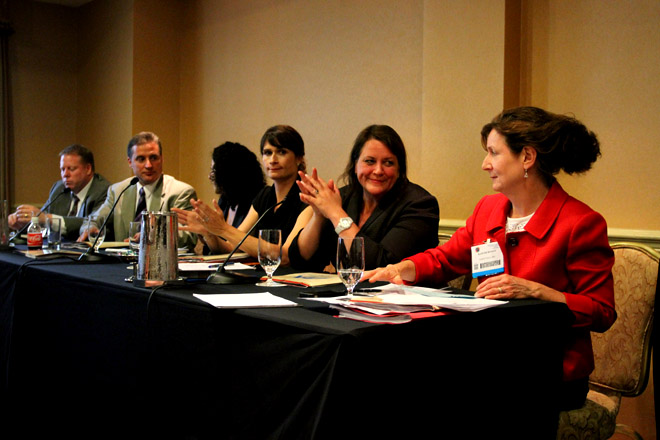Illinois strengthened its legal arsenal against human trafficking this weekend when Gov. Pat Quinn signed House Bill 5278 into law. The new legislation aims to provide further protection and services for trafficking victims while also allowing prosecutors to crack down on pimps and other offenders.
The law applies to both minors and adults, and shares a number of similarities with the federal Trafficking Victims Protection Act, passed in 2000. The TVPA and its subsequent reauthorizations created new categories of human trafficking crimes and provided protections and benefits for human trafficking victims. Similarly, the new Illinois law extends the statue of limitations for offenders and broadens the definitions of “serious harm” and “involuntary servitude.”
 The signing came a day after the American Bar Association’s Juvenile Justice Committee hosted a panel to address the “epidemic” of juvenile sex trafficking in Chicago. While authorities confront traffickers for their offenses, it can be equally difficult to work with trafficked youth, many of whom don’t consider themselves victims of sexual abuse.
The signing came a day after the American Bar Association’s Juvenile Justice Committee hosted a panel to address the “epidemic” of juvenile sex trafficking in Chicago. While authorities confront traffickers for their offenses, it can be equally difficult to work with trafficked youth, many of whom don’t consider themselves victims of sexual abuse.
“This is a hidden population,” said Katherine Kaufka Walts, a panelist from the Center for the Human Rights of Children at Loyola University. “No one is self-identifying, no one’s raising their hand to say ‘I’m a victim of sex trafficking, I’m a victim of human trafficking.’”
According to Walts, current estimates suggest between 100,000 and 300,000 U.S citizen children are trafficked in the nation each year. However, data limitations prevent researchers from obtaining precise figures, and research typically excludes boys and LGBT youth.
“We’re all embracing this narrative of the girl and the pimp,” said Kate Mogulescu, project director for the Trafficking Victims Legal Defense & Advocacy Project. “And we understand that and we see that, that it is very common. But there’s another population [of boys and LGBT youth] that’s being affected by this, that’s really not being discussed. That’s a challenge.”
Street prostitution of minors, usually advertised over the Internet, is a primary form of human trafficking in Chicago. Panelist and federal Judge Virgina M. Kendall of the Northern District of Illinois also said gang-involved youth are one of Chicago’s major at-risk groups for trafficking.
“[Girls] are used as kind of rewards for gang activity,” Kendall said. “‘You did something good for the gang on the street, then you get to have sex with this girl, she’s the best girl,’ et cetera. And they become tossed and shared around the gang, and they feel very much like they can’t break from the gang the same way a gang member can.”
Other at-risk youth include missing children, children of migrant workers, children with disabilities and children who abuse substances. Minors in the foster care and child welfare systems also make vulnerable targets.
The varied backgrounds of trafficked youth necessitate a wide range of services. Many must confront issues such as immigration status, pregnancy, custody battles and prior legal offenses in addition to the horrors of the sex trade.
But recent legislation – like House Bill 5278 – has made it easier for minors in the sex trade to interact with the legal system. Illinois Safe Children’s Act, signed by Gov. Quinn in 2010, decriminalized sex-trade involvement for children younger than 18. Deemed unable to consent to their own commercial sexual exploitation, minors are no longer considered perpetrators or juvenile prostitutes. Instead, they’re referred to as victims, a label which has caused some controversy among trafficking authorities.
Recently other states have also reformed laws dealing with child prostitution. One significate example is Georgia where earlier this year lawmakers essentially erased the threat of prosecution of minors for prostitution, if the minor was coerced or deceived into the act — or, effectively, if they were trafficked. The 2011 law also toughened penalties for prostituting children 16 or under, making the punishment 10 to 30 years in prison and up to a $100,000 fine. The same crime involving a 17- or 18-year old remained unchanged: five to 20 years in prison and a fine between $2,500 and $10,000. And the law disallowed the accused trafficker to claim as a defense that he or she did not know the child’s age.
In 2011, Illinois become one of the eight states with vacating conviction legislation, according to the Polaris Project. This law allows courts to clear convictions of prostitution from trafficked victims’ records.
Despite such legislation, barriers to beating Chicago’s sex trade still stand strong. While panelists said it isn’t legislation that’s lacking to protect victims, but rather the resources to make the law a reality. Challenges include a lack of housing for victims, disparate responses from authorities and the victims’ general distrust of law enforcement.
Take just New York City, said Mogulescu. That city has fewer than 50 beds to shelter trafficked victims taken into protective custody.
“We need to talk about the details of how do we make this work,” Walts said. “And I think we need to hear more from the kids frankly, about what works, what doesn’t, what got them there. No one’s asking the youth.”
Additional reporting by Maggie Lee
Maryam Jameel and Natalie Krebs are reporters with the Chicago Bureau





























